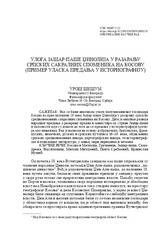Prikaz osnovnih podataka o dokumentu
Uloga Jašar-paše Džinolija u razaranju srpskih sakralnih spomenika na Kosovu (primer ulaska predanja u istoriografiju)
The role of Jazzar pasha in the destruction of the sacral monuments on Kosovo (an example of tradition entering historiography)
| dc.creator | Šešum, Uroš | |
| dc.date.accessioned | 2021-10-12T12:42:39Z | |
| dc.date.available | 2021-10-12T12:42:39Z | |
| dc.date.issued | 2018 | |
| dc.identifier.issn | 0352-5732 | |
| dc.identifier.uri | http://reff.f.bg.ac.rs/handle/123456789/2533 | |
| dc.description.abstract | Rad se bavi analizom uloge polunezavisnog gospodara Kosova iz prve polovine 19. veka Jašar-paše Džinolija u razaranju srpskih srednjovekovnih sakralnih spomenika na Kosovu. Data je analiza razvoja narodnog predanja o razaranju crkava i manastira od strane Jašar-paše i okolnosti koje su dovele do toga da CE predanje u istoriografiji tretira kao činjenica. Rađe napisan na osnovu dubrovačkih, britanskih, francuskih, nemačkih, ruskih i srpskih putopisa 16-19. veka, objavljenih srpskih srednjovekovnih izvora, kartografskih izvora, te istoriografske i etnološke literature, u manjoj meri periodike i štampe. | SR |
| dc.description.abstract | Serbian lore from Kosovo, regarding systematic destruction of Serbian medieval churches and monasteries, committed by the local and semi-independent Jashar pasha in the early 19th century, was introduced in Serbian historiography by way of Serbian travelogue literature during the second half of 19th and early 20th century. According to lore, Pasha destroyed monasteries Vojsilovica and Burinci, Samodreža church and several other village churches for the purpose of using building materials for his water mills. Allegedly, construction materials of destroyed church in Lipljan and several surrounding village churches were used for construction of the bridge on river Sitnica, while, also allegedly, he took the floor from Gračanica monastery for his hamam. Lead from the monastery roof was used to cover the mosque in Priština. After a critical analysis of such lore, it can be stated that Pasha did not demolish a singe church or monastery, but in fact, for his projects, he used materials from the already destroyed temples. These writings of lore, combined with the local population's perception of him as a cruel master, left a historic view of him as being the main destroyer of Serbian medieval churches and monasteries. Release of lore version of Serbian history, made by folklore writers, contributed to the rapid dissemination of inaccurate information. This had an encouraging affect which, as time went on, associated Pasha's name with the large number of destroyed churches. In Serbian historiography such usage of travelogue literature from the 19th century and further developed oral tradition recorded by ethnologists as relevant historical sources, have led to the adoption of unverified data as historical fact. | EN |
| dc.publisher | Matica srpska, Novi Sad | |
| dc.relation | info:eu-repo/grantAgreement/MESTD/Basic Research (BR or ON)/177014/RS// | |
| dc.rights | openAccess | |
| dc.source | Zbornik Matice srpske za društvene nauke | |
| dc.subject | Vojsilovica | SR |
| dc.subject | Samodreža | SR |
| dc.subject | Panta Srećković | SR |
| dc.subject | M iloš M ilojević | SR |
| dc.subject | Kosovo i Metohija | SR |
| dc.subject | Jašar-paša | SR |
| dc.subject | Eračanica | SR |
| dc.subject | Branislav Nušić | SR |
| dc.subject | Vojsilovica | EN |
| dc.subject | Samodreža | EN |
| dc.subject | Panta Srećković | EN |
| dc.subject | Miloš Milojević | EN |
| dc.subject | Kosovo and Metohija | EN |
| dc.subject | Jashar Pasha | EN |
| dc.subject | Gračanica | EN |
| dc.subject | Branislav Nušić | EN |
| dc.title | Uloga Jašar-paše Džinolija u razaranju srpskih sakralnih spomenika na Kosovu (primer ulaska predanja u istoriografiju) | SR |
| dc.title | The role of Jazzar pasha in the destruction of the sacral monuments on Kosovo (an example of tradition entering historiography) | EN |
| dc.type | article | |
| dc.rights.license | ARR | |
| dc.citation.epage | 872 | |
| dc.citation.issue | 168 | |
| dc.citation.other | (168): 849-872 | |
| dc.citation.rank | M24 | |
| dc.citation.spage | 849 | |
| dc.identifier.doi | 10.2298/ZMSDN1868851S | |
| dc.identifier.fulltext | http://reff.f.bg.ac.rs/bitstream/id/1254/2530.pdf | |
| dc.type.version | publishedVersion |

